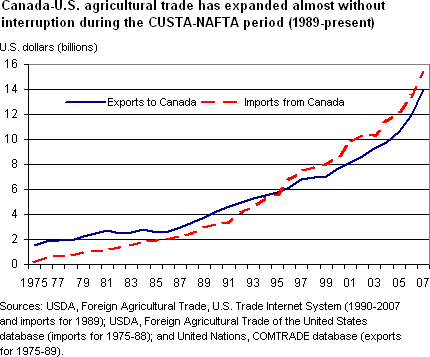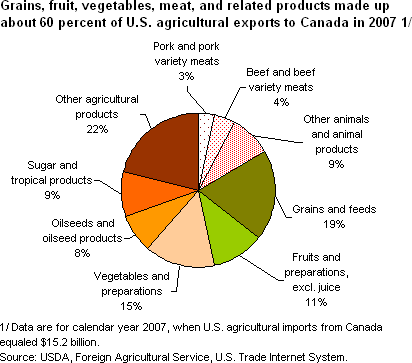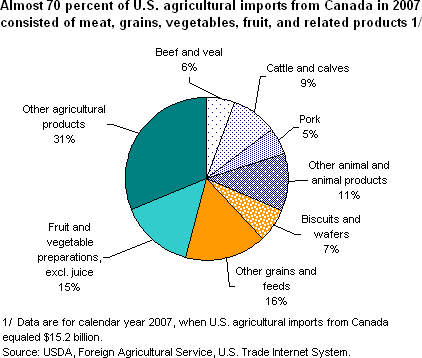|
Canada is a major participant in international agricultural
trade. In 2007, Canada's total agricultural exports
(to all countries) exceeded US$32.6 billion, and corresponding
imports surpassed US$24.2 billion, according to Canadian
statistics. The United States is Canada's largest
agricultural trading partner, buying 56 percent of Canadian
exports and supplying 61 percent of Canadian
imports. In addition, Canada is the leading agricultural
trade partner of the United States. In 2007, Canada accounted
for 16 percent of U.S. agricultural exports and 21 percent
of imports, as defined and categorized by USDA.
The heightened level of integration
between the U.S. and Canadian agricultural sectors is due
in part to the Canada-U.S. Free Trade Agreement (CUSTA),
which was implemented in 1989 and subsumed by the North
American Free Trade Agreement (NAFTA) in 1994. From 1989
to 1998, CUSTA and NAFTA dismantled virtually all tariff
and quota barriers to Canada-U.S. agricultural trade, with
a few notable exceptions: U.S. imports of dairy products,
peanuts, peanut butter, cotton, sugar, and sugar-containing
products and Canadian imports of dairy products, poultry,
eggs, and margarine. During the CUSTA-NAFTA period, Canada-U.S.
agricultural trade has expanded
almost without interruption. Between 1988 (the last year
prior to CUSTA's implementation) and 2007, U.S. agricultural
exports to Canada expanded at a compound annual rate of
7.8 percent, while agricultural imports from Canada grew
at a rate of 10.0 percent.

Much of Canada-U.S. agricultural
trade consists of intra-industry trade, meaning that within
certain sectors, each country exports products to the other.
In grains and feeds,
intra-industry trade encompasses numerous processed products,
including dog and cat food for retail sale; mixes and doughs;
pastries, cake, bread, and pudding; breakfast cereal; and
uncooked pastas. Beef and pork are prominent examples of
intra-industry trade outside the grains and feeds sector.
Grains, fruit, vegetables, meat, and related products accounted
for about 60 percent of U.S. agricultural exports to
Canada in 2007. Among the leading exports were pork (US$589
million), beef (US$475 million), dog and cat food for retail
sale (US$426 million), fresh lettuce (US$361 million), and
confectionery containing cocoa (US$332 million).

Roughly 70 percent of U.S. agricultural imports from Canada
in 2007 consisted of meat, grains, vegetables, fruit, and
related products. All four leading imports in 2007
were in the category of animals and animal products:
live cattle and calves (US$1.4 billion), beef and veal (US$842
million), pork (US$815 million), and live swine (US$653 million).
The fifth leading import was frozen potatoes (US$606 million).

Selected U.S.
agricultural exports to Canada
Selected U.S.
agricultural imports from Canada
To view more detailed U.S.-Canada agricultural trade statistics,
go to USDA Foreign Agricultural Service's U.S.
Trade Internet System.
|



